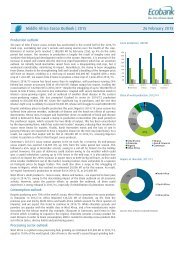www.ebook777.com
Make_Getting_Started_with_Processing_Second_Edition
Make_Getting_Started_with_Processing_Second_Edition
Create successful ePaper yourself
Turn your PDF publications into a flip-book with our unique Google optimized e-Paper software.
Example 5-16: Tap a Key<br />
In this example, the second line is drawn only when a key is<br />
pressed:<br />
void setup() {<br />
size(240, 120);<br />
}<br />
void draw() {<br />
background(204);<br />
line(20, 20, 220, 100);<br />
if (keyPressed) {<br />
line(220, 20, 20, 100);<br />
}<br />
}<br />
The key variable stores the most recent key that has been<br />
pressed. The data type for key is char, which is short for “character”<br />
but usually pronounced like the first syllable of “charcoal.”<br />
A char variable can store any single character, which<br />
includes letters of the alphabet, numbers, and symbols. Unlike a<br />
string value (see Example 7-8 on page 97), which is distinguished<br />
by double quotes, the char data type is specified by single<br />
quotes. This is how a char variable is declared and assigned:<br />
char c = 'A'; // Declares and assigns 'A' to the variable c<br />
And these attempts will cause an error:<br />
char c = "A"; // Error! Can't assign a String to a char<br />
char h = A; // Error! Missing the single quotes from 'A'<br />
Unlike the boolean variable keyPressed, which reverts to false<br />
each time a key is released, the key variable keeps its value until<br />
the next key is pressed. The following example uses the value of<br />
key to draw the character to the screen. Each time a new key is<br />
pressed, the value updates and a new character draws. Some<br />
Response 67



